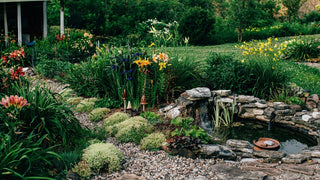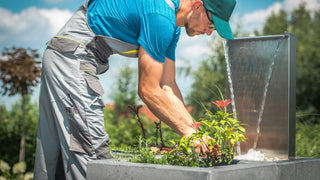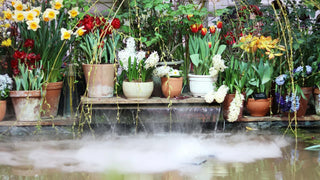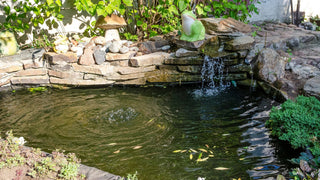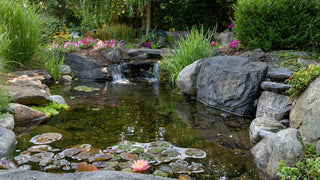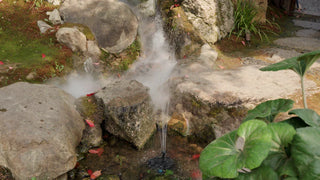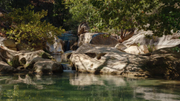
Dreaming of a backyard stream that steps from pool to pool and ends in a silver curtain of water? A multi-level pond design doesn’t just look gorgeous—it oxygenates, filters naturally, and creates gentle sound that softens street noise. With a little planning and the right solar-ready hardware, you can build a tiered waterfall pond that’s easy to maintain and affordable to run. Below is a practical guide that blends aesthetics with hydraulics, plus Poposoap recommendations drawn from their product manual and brand story of simple, eco-friendly water features.
1) Design Aesthetics and Functionality
Start with purpose and sightlines. A layered water garden should read as one composition from your main viewing spot (patio, kitchen window, or deck). Three levels usually feel natural: an upper “spring,” a mid pool that widens for plants, and a lower pond for fish. Curved, organic edges are more forgiving than right angles and make rock placement look intentional. Use larger anchor boulders at transitions and stack smaller river stones to feather hard lines.

Functionally, each terrace should do a job:
- Upper pool: a shallow basin that catches the first spill and hides plumbing.
- Middle pool: a planting shelf for marginals (iris, pickerel rush) that strip nutrients and calm flow.
- Lower pond: deeper refuge for fish and the clearest mirror for reflections.
Add partial shade on the western side (trees, pergola, or tall grasses) to slow algae in summer, and plan a discrete equipment zone where pumps, filters, and cables (if any) stay out of view.
2) Water Flow and Water Pressure Considerations
Waterfalls are about volume and lift. Get these right and the system will hum.
- Turnover: Aim to recirculate the full volume of the lower pond every 1–2 hours for good oxygenation and clarity.
- Head height: Total “head” is vertical lift plus friction losses in hose, fittings, and spillways. Short, direct runs with gentle bends are best.
- Waterfall look vs. flow: For a thin, glassy sheet, estimate ~100 GPH per inch of spill width. For a softer, rivulet look, 50–75 GPH per inch often suffices.
- Pressure reality with solar: Solar pumps are most efficient with modest lift and daylight operation. Keep spill heights reasonable and hose diameters wide to minimize friction. If you want taller features, consider pairing a solar circulation pump with a separate aeration device so oxygen stays stable even when the waterfall slows under cloud.
Get in the habit of measuring actual flow at the return (simple bucket test). Numbers beat guessing every time.
3) Construction Steps
Step 1: Map the tiers
Sketch the footprint and elevation changes. Mark the waterline of each level with stakes and string. Plan a shallow plant shelf (15–25 cm), a mid shelf (45–60 cm), and a deep area (90+ cm) if you’ll keep koi.

Step 2: Excavate and step the basins
Dig top to bottom so spoil from higher tiers can help shape lower edges. Each ledge should slope gently toward the next spill to guide debris and prevent stagnant pockets.
Step 3: Underlayment and liner
Lay geotextile underlayment across all tiers to cushion roots and stones. One continuous liner is ideal; let the sun warm it, then press it snugly into shelves. Pleat excess neatly at corners and anchor temporarily with smooth rocks.
Step 4: Plumbing and filtration
Place an intake strainer or pre-filter box at the lower pond, route flexible tubing up the bank, and terminate at your spillway(s). Include a tee and valve if you want a side stream or bypass. Add a biological filter box before the waterfall return so water is cleaned before it’s displayed.
Step 5: Rock the edges
Set big stones first to pin the liner and define the cascade. Dry-stack flats to create overhangs that hide liner and produce a crisp sheet of water. Fill gaps with cobbles and gravel; rinse stones before final placement to reduce clouding.
Step 6: Plant and fill
Pot marginals in aquatic baskets with gravel caps and place them on shelves. Add lilies to the mid pool for shade. Begin a slow fill; as weight settles the liner, recheck rock stability and the spill line. Start the pump and adjust weirs until the sheet holds evenly without “fingers.”
Step 7: Commissioning
Run the system for a week before adding fish. Rinse filter foams in pond water, seed bio-media, and confirm no leaks around the spill edges.
4) Poposoap Pump Matching Recommendations
Poposoap’s solar lineup is designed for simple installs—no trenching, no cords across lawn. Match gear to your design goals:
- Primary circulation: A Poposoap Solar Fountain Pump in the mid-range class handles small to medium multi-level builds, turning over a few hundred gallons per hour in sun. Keep lift modest and hoses short for best performance.
- Waterfall display: Choose a Poposoap Waterfall Kit sized to your spill width. Narrow 8–12 inch lips pair with roughly 600–800 GPH for a lively sheet; broader 24 inch features look best around 1,000–1,200 GPH. If you want a gentler sound, dial back flow with an inline valve.
- Filtration backbone: A Poposoap Solar Pond Filter provides layered mechanical foams plus bio-media, with optional UV on certain configurations to control green water. Place it in the return path so clean water feeds the falls.
- Supplemental oxygen: Add a Poposoap Floating Pond Fountain or solar pond aerator in the lower pool. Aeration keeps dissolved oxygen high during heat and on hazy days, supporting fish and bacteria even if the waterfall slows.
- After-dark ambiance: Poposoap Pond Lights (RGB or warm white) are IP68-rated and made for continuous submersion—perfect for highlighting the cascade at night without creating glare.
These components follow Poposoap’s design approach: UV-stable housings, straightforward assembly, and solar-first efficiency to lower running costs.
5) Success Case Gallery (Ideas to Copy at Home)
- Courtyard “three-step” stream: A compact tiered waterfall pond drops 30 cm from a ceramic bowl “spring” into a 120-cm middle pool planted with iris, then down a short rill into a 1,200-L fish pond. A Poposoap solar pump recirculates through a filter box to a 12-inch spillway—quiet, clear, and cord-free.
- Woodland edge layered water garden: Two offset basins linked by a rock weir, under dappled shade. Marginals on the mid shelf do most of the filtering; a Poposoap floating fountain adds backup aeration during hot afternoons.
- Modern sheet-fall mirror: A clean rectangle with a raised upper trough feeds a 24-inch spill into a deep reflective pool. A Poposoap waterfall kit creates an even, architectural sheet, while warm-white pond lights wash the wall after sunset.
A beautiful multi-level pond design lives at the intersection of art and flow. Shape tiers for plants and habitat, size your pump to the spillway you want, and keep plumbing simple to preserve pressure. With Poposoap’s solar pumps, filters, aerators, waterfall kits, and submersible lights, you get reliable circulation and oxygen without a power bill—so your tiered waterfall pond stays the relaxing centerpiece it was meant to be.


